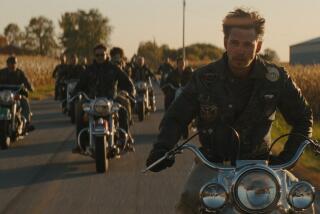Think ‘Hamlet’ on Harleys
His kickstand dragged on the pavement, and his mirror was spinning around. Worthless. Even Charlie Hunnam, with the little experience he has riding motorcycles, knows a road hazard when he rides one, and the beat-up Harley-Davidson fit the bill.
“This bike’s . . .,” Hunnam trailed off, eyeing his ride with derision as he pulled off the road, unstrapped his brain bucket and ignited a cigarette.
Hunnam was blurring the lines between his fictional role as a motorcycle miscreant on FX’s new outlaw biker drama, “Sons of Anarchy,”#Nav/Homepage and his real life as an actor. He was spending a rare day off from filming to ride the dusty Hollywood hills that double as Charming, Calif., the fictional setting for the show. And he was riding the only bike the producers would let him borrow -- a barely working backup model with a sticker, rather than paint, for the scythe-and-skull tank art. A bike that -- at some point in a future episode -- will be crashed.
Like most of “Sons’ ” fictional club members, Hunnam doesn’t actually own a motorcycle. He learned to ride once he landed the part. Ron Perlman, who plays the club’s coldhearted leader, has taken one riding lesson and has so little experience in the saddle, he says, “that it probably does more harm than good” to see him biking on camera.
Riding skills aside, FX has found a loyal following for its new motorcycle show. “Sons of Anarchy,” which debuted in early September, has been among the most consistent first-year dramas for the 14-year-old network. Thanks to its steady weekly audience of about 5 million viewers, the Wednesday night show was picked up for a second season after just four episodes.
Motorcycles, and the outlaw ilk that are drawn to them, have long been fodder in film. But with the exception of various reality shows, they haven’t had much play on TV in recent years. When motorcycles do make an appearance on the small screen, they tend to be props -- ridden to make a character look tough or cool, not to drive the plot or give insight into the culture.
“The stereotype most people have of the subculture is usually one of two things: these furry, fuzzy teddy bears like ‘Wild Hogs,’ or the scumbag white trash living in trailers, smoking meth, which is as inaccurate as the other one,” said the show’s creator, executive producer Kurt Sutter, who developed the characters and plots by hanging out with “one of the bigger clubs” in Northern California. Which one, he won’t say.
“What was eye opening to me was the way these guys lived. These sort of normal, middle-class lives. They all have day jobs,” he added. “These guys all have family lives, and they have the same conflicts and problems that all married couples have. They face the same conflicts that all people who work together in proximity for long periods of time face. “
--
Ensemble cast
It was the unexploited and darker elements of this renegade subculture that drove Sutter to create “Sons of Anarchy,” a drama about a gun-running motorcycle club doling out eye-for-an-eye justice in a small California town. The show’s ensemble cast features Hunnam as a swaggering, if pretty-faced, bad boy; Perlman as his tough-as-nails stepfather; and Katey Sagal as the club’s leather-and-lace matriarch -- a woman who won’t let anything get in the way of her family, least of all her conscience.
Peel back the leather and silence the loud pipes, and you’ve got a bunch of guys and their “old ladies” who are just trying to get by and do the right thing. At its core, Sutter says the show is about family, which may explain why it’s attracting so many female viewers -- about 40% of its audience is women. And that’s despite intense brutality and strong sexuality that, so far in the series, has ranged from boozy brawls and blowtorched-skin scenes to rape, prostitution and castration.
On set for filming Episode 11, the fictional tensions were beginning to rise, though they had yet to disintegrate into the inevitable Tarantino-esque violence at the Sons of Anarchy clubhouse -- a ratty bar with rows of mug shots on one wall and a collection of nudie pictures behind the bar. The clubhouse is fake, of course, but the cigarettes were real and so was their smoke, which filtered through the diffused light, past the half-empty bottles of Bud-like near beer and the filled-to-capacity ashtrays on the tables. As much as it strives to demystify biker stereotypes, the show still traffics in the standard triumvirate of sex, drugs and rock ‘n’ roll -- and the T&A; and tats that go with it. At least it feels authentic.
The ghoulish Sons of Anarchy logo the club members wear as (temporary) back tattoos and also sport on their leather vests were designed by well-respected San Francisco tattoo artist Freddy Corbin; Corbin also was behind the individual tats for each of the actors, who have them applied each day before shooting.
Accurately portraying any sort of subculture on TV is tricky -- all the more so with a group as secretive as a motorcycle club. In a world where loyalty and respect are everything, such groups aren’t keen to be outed -- or misrepresented.
“The fact that we’re taking this culture and trying to put them in some sort of box and write about it and put it on TV sort of flies in the face of the nature of being outlaw,” said Sutter, who receives dozens of e-mails a day from real-life outlaw club members. “Generally, the feedback has been positive. I’ll just say that most of the e-mails have a picture attached.”
Sutter was previously an executive producer of the FX hit show “The Shield,” a dark police corruption drama that recently wrapped after seven seasons. Perhaps not surprisingly, many of the themes in “Sons of Anarchy” (corruption, greed, justice) as well as its architecture (multiple plot lines with an ensemble cast) -- mirror those of “The Shield.”
But where the Los Angeles Police Department was the inspiration for “The Shield,” Sutter’s muse was Shakespeare. Specifically, Hamlet, and the idea of a man in the making.
--
Family history
In “Sons of Anarchy,” Hamlet is Jax, played by Hunnam, who has appeared in films such as “Children of Men” and “Cold Mountain” and made his first splash on the British version of “Queer as Folk.” Jax is a member of the gang by birth; his father founded the group. But Jax’s dad is now dead, and his stepfather, Clay, played with a chilly stoicism by Perlman (“Hellboy”), is running things -- taking its members to morally questionable places with no regard, respect or remorse for the club’s past principles.
Jax’s mom is played to creepy perfection by Sagal. As Clay’s wife, her character too has little nostalgia for the past. The situation has Jax questioning where the group is heading and what he should do about it.
At 28, Hunnam is the youngest actor to be cast in a leading role on an FX show -- a situation that required some convincing of the FX brass. But Sutter was dead set on hiring the Englishman, having seen his performance as a brawling soccer fanatic in the indie film “Green Street Hooligans.”
Perlman was actually the second actor to play Clay. Originally, Scott Glenn had been cast and appeared in an earlier version of the pilot. Sagal got her part “because I was sleeping with the boss,” she joked. Sagal, best known for her role as the tacky but wise-talking Peg Bundy on “Married With Children,” is Sutter’s wife.
Sutter used a Harley as his primary mode of transportation for six years before selling it to pay for graduate school. He hasn’t had a bike in 10 years, he said, but he recently went to a showroom to check out a Harley-Davidson VRod.
“You did?” asked Sagal, turning to her husband during a break.
“I told you,” Sutter said. “And then I had an accident about three months ago where I fell off a ladder and cracked ribs.”
“There’s no way you’re getting a bike,” Sagal said.
To which, Perlman chimed in: “You should have painted the house on a Harley.”
--
--
latimes.com/entertainment/news/tv
See a video of Susan Carpenter’s ride-along with “Sons of Anarchy.”
More to Read
The complete guide to home viewing
Get Screen Gab for everything about the TV shows and streaming movies everyone’s talking about.
You may occasionally receive promotional content from the Los Angeles Times.






